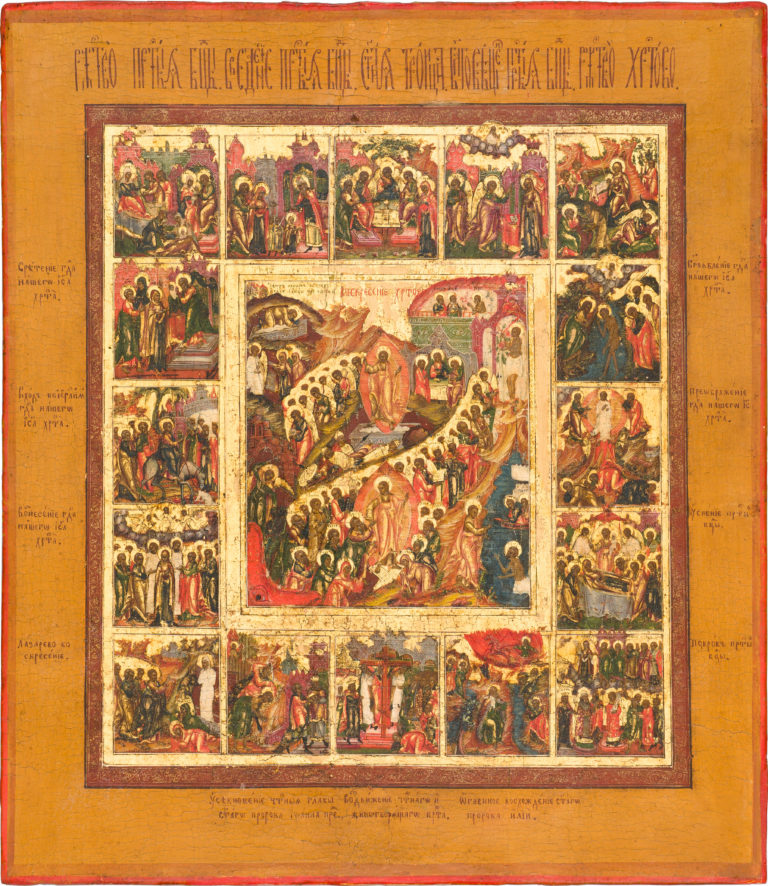The Resurrection—the Descent into Hell, with Church Feasts in 16 Border Scenes
Antique Russian icon. First quarter of the 19th century. Palekh.
Size: 36 х 31 х 2.5 cm
Wood (two panels), two incut support boards (now lost), absence of the incut centerpiece, underlying layer of canvas not visible, gesso, tempera, gold.
The author’s paintwork is in a very good state and is currently covered with a thin web of crazing. Slight chafing and small fallouts of the paint also present. On the reverse of the panel, one can see two abbreviated inscriptions made in pencil: «Б. Я. / гор[шечни]кову» и «[]и Хе[] Гер[]бер[].»
Contact us

The Resurrection—the Descent into Hell, with Church Feasts in 16 Border Scenes
Diagram of the border scenes:
- The Nativity of the Mother of God;
- The Entrance of the Mother of God into the Temple;
- The Old Testament Trinity;
- The Annunciation;
- The Nativity of Christ;
- Candlemas (The Meeting of Christ in the Temple);
- The Theophany (The Baptism of Christ);
- The Entrance into Jerusalem;
- The Transfiguration;
- The Ascension;
- The Dormition of the Mother of God;
- The Raising of Lazarus;
- The Beheading of John the Baptist;
- The Elevation of the Holy Cross;
- The Fiery Ascent of the Prophet Elias;
- The Pokrov (Feast of the Protective Veil of the Mother of God).
The given antique Russian icon belongs to the widespread Eastern Orthodox iconography type of so-called “full-cycle icons” (called “polnitsy” in Russian). Such hand-painted Orthodox icons are quite complex compositions that include the Twelve Great and the minor Feasts of the Church, brought together around the “Resurrection – The Harrowing of Hades” scene. The highly developed Resurrection iconography traditionally includes the scene of Christ Rising from the Tomb. This variation makes its way into Russian iconography already in the 16th century via Western European etchings. An important factor in its reception was the translation of the Gospel of Nicodemus, which was included into Metropolitan Macarius’ Great Almanac. By the middle of the 17th century, the iconographic scheme becomes even more complex, encompassing new events that took place between the Resurrection and the Ascension of Christ. Since the “Rising from Tomb” scene was brought into the upper tier, directly over the “Harrowing of Hades,” the religious icon composition begins to be built on two centers lying along a single axis. This iconographic scheme was first established in Moscow but became increasingly popular in the Volga region (especially in Yaroslavl and Kostroma). In the second half of the 18th century, it was taken up by Palekh religious icon painters, and since that time, we always see this version of the Resurrection as the centerpiece of polnitsy (“full-cycle”) icons. This tradition endures until the early 20th century.
Overall, the iconography of the given antique Russian icon finds many analogies among other 19th-century Eastern Orthodox Church icons. The composition is built on two major scenes – the Rising from the Tomb and the Harrowing of Hades – placed along an axis and united by a diagonal processional line of the Pious marching into Heaven. It is also supplemented by other scenes: Saint Peter at the Empty Tomb; the Revelation of Christ to the Apostles on the Sea of Galilee; the Revelation of Christ to Luke and Cleopas in Emmaus. The number and iconography of the Feast cycle are also typical for religious icon paintings of that time.
Palekh was renowned for its “miniature” painting style, which is clearly seen in this antique Russian icon with artistically painted small border scenes. Although each of them is no more than 5 cm in height, the artist managed to brilliantly place the entire, complex Festive scene with a large number of characters standing before bizarre, highly decorated and ornamented architectural shapes or colorful mountainsides with lights and intricate grasses encompassed by blue-gray clouds. The resonating colors, lavish amounts of gold that fills the background in the religious icon centerpiece and border scenes, the virtuoso ornamentation, and the rhythmic balance of the entire composition clearly illustrate the words of the Paschal Troparion: “Christ is Risen from the Dead, Trampling down Death by Death/And upon those in the Tombs bestowing Life”. This unique antique Russian icon is undoubtedly among the best examples of Palekh religious icon art of the first quarter of the 19th century.